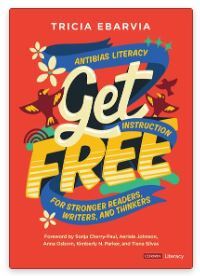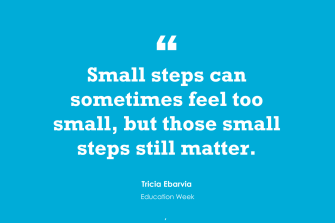
Tricia Ebarvia, educator, creator, guide, has a brand new guide out: Get Free: Antibias Literacy Instruction for Stronger Readers, Writers, and Thinkers. A DEI knowledgeable, Tricia spent a while speaking in regards to the guide for my weblog.
LF: How would you summarize the aim of your guide and the potential worth Okay-12 lecturers would discover in it?
Tricia Ebarvia:
For me, the aim of Get Free is to assist educators learn to create liberatory areas of their lecture rooms—areas the place children and lecturers can convey and turn out to be their genuine and greatest selves, and the place they suppose deeply in regards to the views of others and might impact constructive change.
I feel most lecturers would agree that faculties aren’t simply locations that get children “prepared” for the true world; they will and also needs to be locations the place children can learn to make the world higher than it’s now. To do that, after all, college students must be robust readers, writers, and thinkers, and this work just isn’t separate from—and actually, I argue they’re inherently tied to—anti-bias literacy expertise. We face so many challenges in the present day as a society. Serving to college students to grasp the position of bias in themselves, in others, and within the misinformation and disinformation we see within the media is crucial.
My hope is that my guide may supply lecturers a pathway ahead in embedding anti-bias literacy expertise into the every day work of studying, writing, and pondering we already do in our lecture rooms. My very own apply, and the guide, builds on the scholarship of social-justice educators, and lecturers who decide up my guide will discover a number of sensible methods and shifts that they will check out of their lecture rooms with the intentionality and care we all know makes good apply.
The guide begins with some invites for self-reflection as we unpack the biases we would have as educators. After that, I spend the following chapters exploring create courageous areas rooted in neighborhood and methods to affirm the numerous stunning identities that college students convey with them to class.
The second half of the guide has a number of methods for holding house for doubtlessly tough conversations and increasing and deepening college students’ critical-reading expertise. I hope that it is a guide that lecturers can learn and be taught from but additionally proceed to achieve for all through their profession. Educating is tough, and I hope lecturers can discover a supportive thought associate within the phrases on these pages.
LF: I used to be struck close to the start of the guide the way you mentioned “biases” and a number of other of them that lecturers specifically ought to concentrate on. Are you able to elaborate on a number of of them? [Editor’s Note: See a chart from Tricia’s book below.]
Tricia Ebarvia:
That chapter might have been a whole guide by itself, and there have been many extra biases that I might have written about! One of many central premises of that chapter—and actually, of the whole guide—is that all of us have biases, and that for essentially the most half, these biases are neither good nor unhealthy. However once we don’t take the time to replicate on how these biases inform our pondering, we depart ourselves performing in ways in which may hurt college students, even when unintentionally. I really educate college students about biases as a part of our personal critical-thinking work, and it struck me what number of of those play a task in educating.
For instance, one of many biases I talk about is the nostalgia bias, which is our tendency to romanticize the previous. Sadly, this bias not solely creates an inaccurate evaluation of our previous college students, however it additionally prevents us from totally appreciating the youngsters who’re sitting in entrance of us within the current, who might convey totally different however equally priceless expertise and data into our lecture rooms.
Or think about the anchoring bias, which occurs once we permit preliminary info we would find out about a pupil to tell, typically unfairly, our judgment of them. Over time, earlier than the college yr would start, I’d have colleagues who, with good intentions, share each constructive (“That pupil is such an ideal author!”) and destructive (“Be careful for that pupil …”) suggestions about my college students even earlier than I’d met them. We all know first impressions matter, however once we anchor our expectations of scholars primarily based on these first impressions, we might inadvertently restrict our understanding of what college students can and might’t do. And naturally, all these biases—and the doubtless damaging impression they will have—may be much more pronounced for college kids of shade due to the way in which stereotypes irritate these biases.
As I mentioned, biases are pure; we’re typically performing on them with out even realizing it. However once we decelerate our pondering and turn out to be higher conscious of how these biases could also be impacting our interactions and relationships with children, the higher in a position we’re to disrupt these dangerous impacts.

From “Get Free” – Reprinted With Permission
LF: One of many many causes I preferred Get Free was due to the quite a few sensible examples you present, together with photos from the classroom. That is in all probability an unfair query, however are you able to share three or 4 solutions from the guide that you just suppose lecturers can apply now close to the start of the college yr?
Tricia Ebarvia:
My very own favourite skilled books are those that each provoke my excited about my practices and likewise present methods that I can use instantly within the classroom. I attempted to fill Get Free with a number of sensible suggestions for lecturers. One factor that I feel that’s actually essential for lecturers to recollect is that supporting college students in exploring their a number of and complicated identities isn’t one thing that’s only for the start of the college yr after they’re attending to know you and their classmates. Higher understanding themselves and one another is figure that needs to be carried out deliberately all through the college yr, and so I embrace a number of notebook-writing prompts to make use of and construct upon because the yr goes on.
One in all my favourite instruments is utilizing the Brave Conversations Compass. I tailored Glenn Singleton’s device in my classroom, and it’s typically the “go-to” protocol that I take advantage of with college students, particularly once we’re processing tougher subjects. And talking of dialog, Chapter 4 contains greater than 20 methods and constructions for dialogue that assist college students higher hear and perceive views that they may not have thought of earlier than. General, I feel one of the crucial efficient educational strikes lecturers could make to start with of the yr is to introduce college students to methods and protocols that they will use to discover themselves after which apply these similar methods and protocols to the characters they learn of their novels and the arguments they analyze of their readings.
For instance, one protocol I like to make use of is Who’s Centered? Who’s Marginalized? and Who’s Lacking? or C-M-M. I first ask college students to replicate on their very own relationships: Which individuals are on the heart of their lives? Who do they really feel most linked and obligated to? Who is perhaps within the margins of their relationships? And who—folks or teams—is perhaps lacking of their lives, for any variety of causes? They will then apply this framework to the characters they learn of their books or the views centered, marginalized, or lacking within the arguments they analyze.
LF: As you level out within the guide, many educators work in states the place legal guidelines and organizations is perhaps hostile to some (although, clearly, not all) of the practices you advocate. What particular recommendation do you might have for lecturers in these communities?
Tricia Ebarvia:
I feel it’s a very arduous time to be an anti-bias, anti-racist educator proper now. I do know what educators are going via and have needed to navigate resistance, and even hostility, from some colleagues, directors, mother and father—and generally even children. And but, it’s additionally a time when it’s crucial to embody an anti-bias, anti-racist stance.
At the beginning, I feel the work of justice is about organizing and collaborating. It’s about discovering the colleagues in your division or college who consider, as you do, that faculties can and ought to be locations the place college students’ various identities may be honored and the place college students may be their genuine and greatest selves. Discover your folks. Generally, it’s the lecturers within the classroom subsequent door, however generally, it’s lecturers throughout the nation. I’ve been lucky to have each in my profession.
One factor that the pandemic has taught us is that we will have actually wonderful skilled growth on-line—search for alternatives to attach with different lecturers who can supply help. The established order and oppressive programs proceed as a result of typically those that are most marginalized in these programs are remoted from each other. Discover your folks. I promise they’re on the market.
I might encourage lecturers to do as a lot as they will given the context they’re in. Discuss with colleagues, households, and college students. Each dialog is a chance to be taught what subsequent steps you may take. For some lecturers, that may imply altering out a poem, article, or brief story. For different lecturers, they could be capable of change a significant novel. Small steps can generally really feel too small, however these small steps nonetheless matter. And as exhausting as educating already is, the factor that’s going to maintain lecturers within the brief and long run are the relationships we construct with college students and colleagues. Fill your bucket with these deep and wealthy relationships.

LF: Is there something I haven’t requested you about that you just’d wish to share?
Tricia Ebarvia:
The final phrases I wrote for the guide are within the epilogue, and I’d wish to share them right here as a result of they specific my deepest want for readers of the guide and for all lecturers:
Lecturers learn about love. After we educate with love, we see every of our youngsters with the respect and compassion, complexity and messiness that makes them human. After we educate with love, we lead with grace and openness and hope. After we educate with love, we all know that our liberation is sure in one another. When you’re studying this guide, I hope that it might encourage you to like fiercely even on days when our grief in regards to the world, when folks or programs allow us to down, appears insufferable.
Maybe particularly on these days.
As a result of the listing of issues to battle for is eternal.
LF: Thanks, Tricia!

